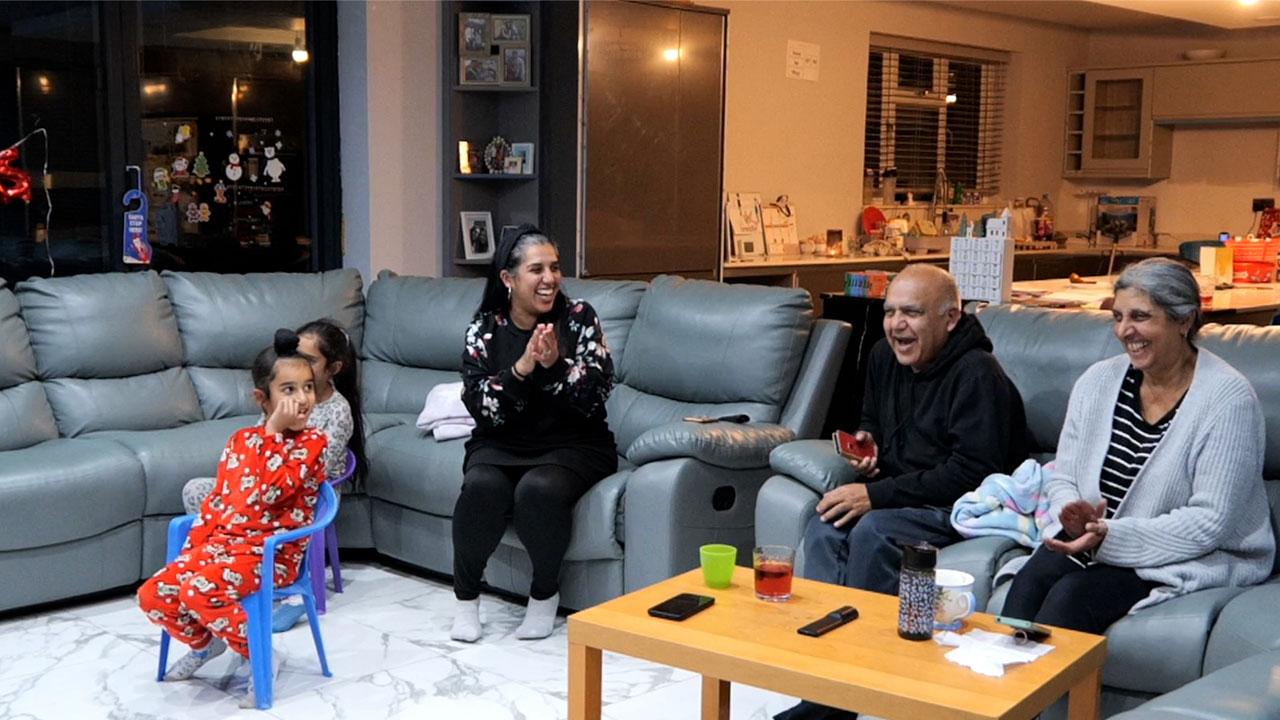In Brief
Planners have long known that the context of advertising exposure plays a key role in effective communications. As the world of video advertising has fragmented across screens and platforms, the variation in the context of video advertising has broadened dramatically. With this as the backdrop, Context Effects explores the nuance of in-home advertising exposure and what contextual factors contribute to create the best (and the worst) occasions for effective advertising.
Methodology
A fusion of qualitative and quantitative research techniques, encompassing literature reviews, ethnographic video interviews and viewing experiments alongside advanced statistical modelling from Map The Territory and Tapestry Research.
Key points
- The right in-home advertising context can increase ad recall by up to 6.3 times
- High quality, professionally-made video content drives 60% higher ad recall than non-professional content
- People are 44% more likely to trust advertising seen within professional content
- TV screens drive the highest advertising recall: 34% more than ads seen on a computer, 60% more than on a tablet/smartphone
- Ad recall increases by 23% when watching with others
In Depth
Background
The context within which you see something impacts how you receive, process and remember things. This underscores the importance of context and its role in advertising effectiveness. With the evolving video advertising landscape, where content spans multiple screens and platforms, taking into account the contextual setting is more important than ever as it has an impact on ad recall. This formed the basis of our study, we recruited Map The Territory and Tapestry Research to produce ‘Context Effects’ and delved into the various contextual factors that influence ad recall. The study also identified the optimal in-home conditions that influence video advertising recall and how they combine to help advertisers achieve success.
Methodology
To ensure that we were able to observe natural in-home viewing behaviour as well as collect hard facts on viewing patterns and experiences, we used a mix methodology of qualitative and quantitative elements.
For the first phase of the qualitative element, Map The Territory (MTT) conducted a literature review that included academic interviews with Daniel Richardson (cognitive psychologist at UCL) and Patrick Alexander (anthropologist at Oxford Brookes).
Subsequently, MTT conducted an ethnographic video study involving twenty diverse households across the UK in December 2023, ten of which participated in viewing experiments over a week to understand various viewing contexts. In order to tease out why people value different viewing contexts, we ran a series of experiments where respondents were asked to watch their usual content but in different contexts i.e. watching apart from other household members, watching in different rooms, on different devices, watching different content, etc. Post experiment interviews were then conducted with eight households to further understand their perspective from the outputs of the viewing experiment.
These qualitative findings informed the quantitative phase carried out by Tapestry Research. They surveyed 2,000 UK consumers aged 18-75 through a viewing diary survey capturing details of up to three viewing occasions from the previous day, resulting in over 5,000 viewing occasions for analysis. The survey included factors like viewing location, companions, source, mood, and mindset, alongside metrics such as advertising recall, enjoyment, brand attribution and if they took any action based on the ad.
So that we could uncover the key factors influencing how context impacts ad effectiveness, we employed a statistical technique called Structural Equation Modelling (SEM). The technique considered 87 different inputs as independent variables e.g. watching with others, watching professional content, etc. The model examined the interrelationships between the variables and their effects on ad recall, producing over 348,000 data points. SEM was chosen for its ability to illuminate the complex dynamics at play within the data and to understand the direct and indirect factors impacting advertising effectiveness.
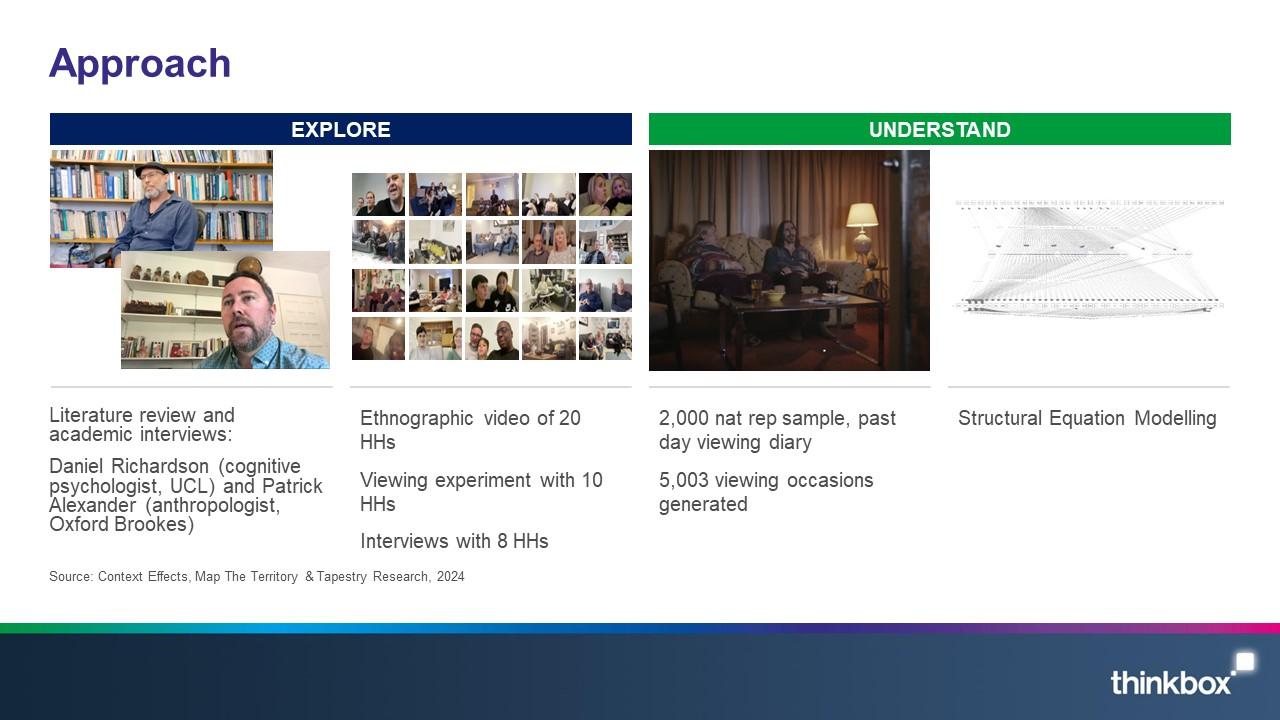
The study measured ad effectiveness using four main metrics - next day ad recall, brand attribution, strength of appeal and took action after the ad. Next day ad recall was chosen as the primary variable in the SEM analysis as it is a good proxy for ad effectiveness – no one sets out to have their ad forgotten and most measures emphasise the value of getting your ad into long term memory.
Findings
Context is key. The right in-home advertising context can increase ad recall by up to 6.3 times.
Looking at specific rooms within the home, the living room emerges as the most impactful, driving better ad recall than any other room, 176% higher than the kitchen, 10% better than the bedroom and 22% higher than any of the other rooms in the house.
So what exactly is going on in living rooms to make this such a powerful environment for advertisers?
Analysis of 87 variables via SEM identified key contextual factors that drive ad recall at home, both individually and collectively. Each of them are an important ingredient in creating the perfect advertising recipe. These are:
- Device
- Other people
- Content
- Mood
- Satisfaction
- Location
Factor 1: The device
Analysis found that the TV screen drives the highest ad recall of all devices, 34% more than ads seen on a computer and 60% more than a tablet or smartphone. This shows the likelihood of remembering an ad is greater when watched on a larger screen. Additionally, audio is important too, analysis shows that having a soundbar in your TV set viewing occasion increased ad recall by 20%. It’s no surprise that the living room performs so well as it is the prime location for viewing on a TV screen.
Factor 2: Other people
The living room is often a shared space, usually considered the central hub of the home and a place where co-viewing is most likely to occur. According to Barb (analysis by TRP), 89% of shared viewing occasions happen in the living room, compared with 7% in the bedroom, 2% in the kitchen and 3% in another room. The analysis found that being with others has a marked impact on ad recall, increasing by 23% vs. watching alone.
Cognitive psychologist Daniel Richardson suggests that watching with others involves multiple layers of ‘social referencing’. We tend to view things from the point of view of our viewing partners – we consciously look at what we think they are looking at. We also learn from their reactions and gain insight into their perspective. Ultimately, we strive to share a similar experience with the other person.
The increased probability of watching content with others in the living room, together with the greater likelihood of being involved in choosing the content that is being watched, plays a pivotal role in driving ad recall and satisfaction.
Factor 3: The content
The living room encourages us to watch and indulge in professional content together. It’s no surprise that professional content dominates living room viewing (73% of viewing was to professional content on a TV set, in comparison to 11% non-professional content on a phone/tablet).
Insights from the qualitative analysis also supports this and highlights how professional content occasions are enjoyed more. Respondents drew comparisons between professionally crafted content, like dramas, which are ideal for social bonding; whilst they suggested that social media is ‘intimate’ and feels too private to share, making it less suitable for the living room environment.
The Context Effects study revealed that ad recall is 60% higher in occasions involving professional content, compared to non-professional content. Moreover, ads within professional content are perceived as 44% more trustworthy and 39% more entertaining.
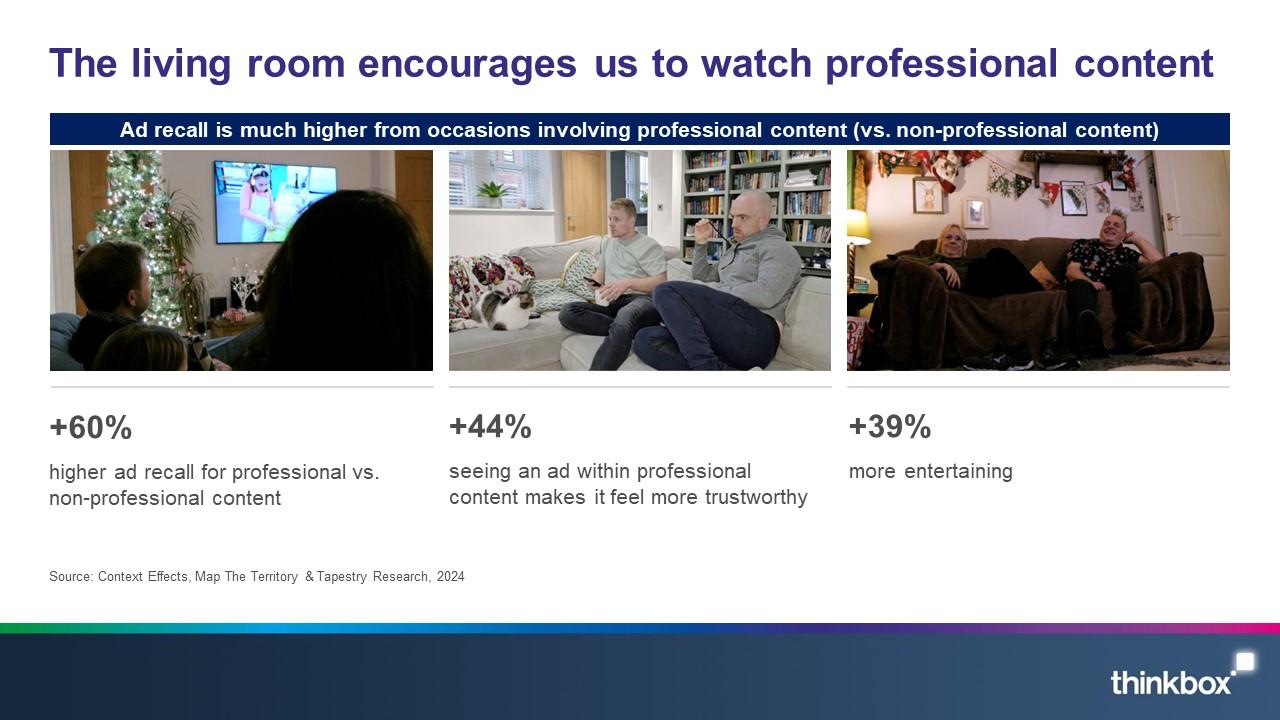
Factor 4: Mood
The living room isn’t just a space for viewing content, it’s often the go-to destination to unwind, escape from the day and stay in touch with others in the household. This effect on mood has a significant impact on ad recall. Compared to the average living room recall, when we are happy in the living room, ad recall increases by 41%, 14% when relaxed and 49% when connected.
Factor 5: Satisfaction
These first four factors all contribute to how satisfied you feel during your viewing experience, which emerges as the largest factor influencing ad recall in the model as they both directly affect ad recall and indirectly by enhancing satisfaction. Research shows that you are 14% more likely to feel satisfied and fulfilled when watching content in the living room compared to other rooms.
The physical environment and the communal nature of TV viewing, which often provides a reason for household members to gather, makes TV a truly social medium.
Factor 6: Location
The living room is a rich and complex ecosystem and is the only room where we see so many factors at play. This powerful combination creates a strong impact on ad recall and makes it an ideal environment for advertising.
Looking at the output from the SEM model in its entirety, the complexity of the living room ecosystem emerges. There are four factors that directly drive ad recall and also, indirectly affect it through satisfaction with the viewing occasion, which further dials-up the combined impact on ad recall. The diagram below details the relationship between these factors, the thicker the arrow, the stronger the effect on ad recall.
The living room, uniquely, brings all these factors together, and data from the SEM shows how each of these factors are influenced by the living room e.g. being in the living room is a very strong predictor of using a TV screen and for watching a certain type of content.
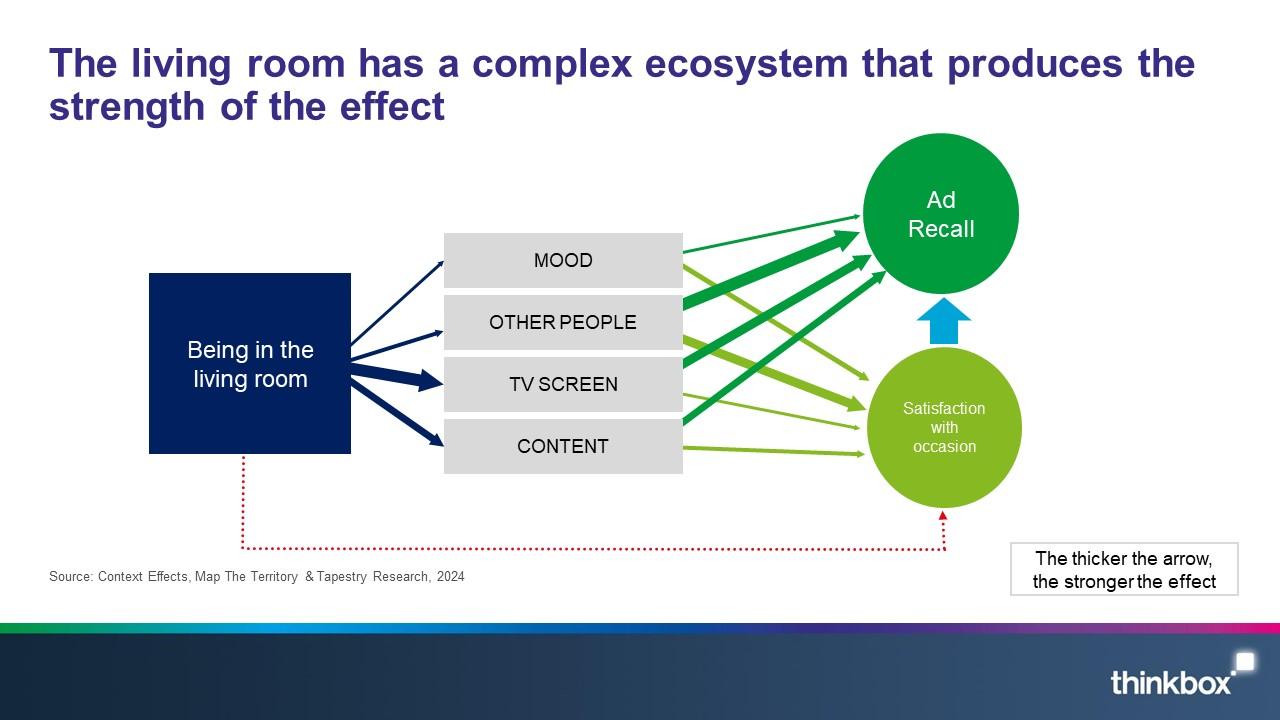
The dotted line connecting ‘being in the living room’ and ‘satisfaction with occasion’ shows how simply just being in the living room is a direct driver of satisfaction regardless of the presence of any of the other factors.
When we compare this ‘ecosystem’ to other rooms in the house, such as the bedroom and kitchen, we can see that there are less factors at play. The reduced number of factors means there is less complexity, and subsequently lower ad recall. The complexity in the living room is its strength.
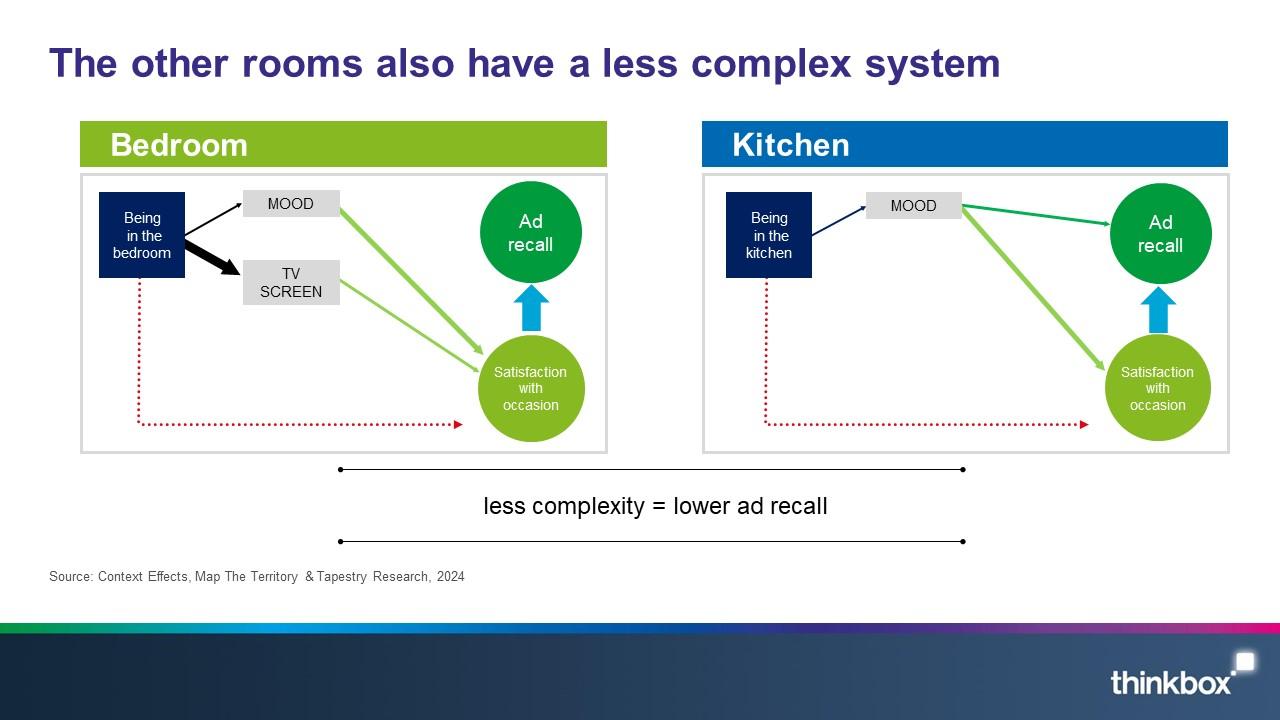
People don’t gather to watch TV, they watch TV to gather.
In this environment, ads are all part of the experience. Analysis shows that people find the ads 80% less intrusive in professional content vs. non-professional content. The ads featured in TV content are seen as seamless, less disruptive and more immersive as data suggests that people are 2x more likely to repeat or mimic the ads (vs. alone). This number increases to 3.2x if watching with children.
Ultimately, the living room is a unique environment compared with other spaces in the home. It’s a well utilised space, 76% of households say that this is where they spend the most time together and where they are most likely to congregate. It’s a less hierarchical environment, where no one is in charge and items belong to everyone in the household. It’s a space where decision making is shared, and 68% of households say that this is where the most important conversations take place.
Contrastingly, other spaces in the home do not share these unique characteristics. While the kitchen might be a social space, it’s inherently more hierarchical e.g. parents are more in charge, people ‘own’ items such as mugs or gadgets. The bedroom, on the other hand, is much more private, it’s not a social space and can be seen as a personal sanctuary. Essentially, the living room is the centre of gravity of the home.
The magic of the living room is the shared nature of the experience, the ads are bonding material, the valuable glue that is used by the household to forge stronger connections. The ads represent products from outside of the home, it provides a valuable opportunity to update your understanding of your housemates, exposing their thoughts on the products. Similarly, the presence of others also helps fellow household members to better understand the ads, allowing the opportunity for further comprehension by encouraging conversation.
This is why ads are so memorable in this environment, the more shared and synchronised our experiences are, the better in terms of social bonding. It allows for deeper levels of processing, as the more layers of eyes we’re looking through, the more we are thinking about that experience. The ads get seared into the households collective memory. This is made possible via a variety of different factors, such as:
- A more familiar environment – which allows us to anchor memories to it more easily.
- Deeper processing – because the ads are processed with our fellow household members in mind, as a result we think about them more deeply, and through their eyes.
- More discussion – discussing things post exposure is where we really remember and construct our ‘shared reality’.
- More brains the better – the ads become part of the household’s collective memory.
This unique ability to bring households together and allow the ability to bond, produces an environment where advertising is much more welcome.
In summary
Context Effects set out to discover the contextual factors that influence video advertising recall.
Using a combination of ethnographic research and advanced statistical modelling, Map The Territory and Tapestry Research identified the contextual factors that drive ad recall and highlighted that the living room offers by far the most powerful combination of the factors.
The research showed that the right in-home context can increase ad recall by up to 6.3 times and reminds us that context has a direct effect on communications impact – highlighting that context should be taken into account to ensure that the right AV platforms are being leveraged.
The content surrounding the ad is also a key determinant of advertising success. High quality, professionally-made video content drives 60% higher ad recall than non-professional content. People are also 44% more likely to trust advertising seen within professional content.
The most likely place for professionally-made content to be watched is the living room. The living room encourages shared viewing (increasing ad recall by 23%) and viewing on a larger screen (which drives the highest ad recall, 34% more than computers, and 60% more than tablet/smartphone). It also provides the perfect environment to leverage conversations and comprehension, with the less hierarchical nature of the space providing the perfect surroundings to provoke discussion and to aid the conversations that build and reinforce memory structures.
 Thinkbox
Thinkbox